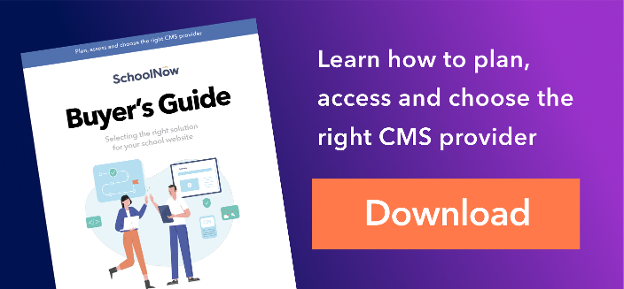What all does your school really need for its new website? Are you confused by all the many options available?
When sizing up potential school content management system providers, be sure not to confuse their capabilities with your requirements. What your school or district needs may not necessarily be everything they’re offering or suggesting. They may be selling you bells and whistles, when all you need is bells.
It’s important that your selection committee starts with a full understanding of its requirements and not force what a vendor insists you need.
Each school content management system provider has its own formula for building effective websites: some are tried and true and have been in place for years; some are more current and in tune with evolving web technologies and best practices.
When establishing your requirements, be sure to look for a provider’s ability to meet the cornerstones an effective CMS-school partnership: usability, accessibility and support.
3 keys to selecting a school CMS
There are many considerations that go into picking the right CMS provider. The following three should form the foundation in your decision-making.
1. Usability
Usability is important from the perspective of both the visitors to your website, and the ones managing it. A CMS that is unfriendly to either or both of these user groups can greatly diminish a website’s effectiveness. How your website looks, the speed of pages loading, intuitive navigation, simplicity for novices, power for advanced users – these and many other factors go into how ‘usable’ your website should be.
The goal of any web page on your website is to either provide exactly what your visitor is looking for or to get them to that next click, quickly and cleanly without a lot of scrolling and maneuvering. Many schools make the mistake of ‘over-designing’ their pages – filling up valuable real estate with huge rotating images or slow-loading content – when they ought to be more concerned with delivering information efficiently.
Usability is a function of good design. Think in terms of a spectrum of good design, where on one end you have gorgeous ‘beauty shots’ of school imagery (close-ups of: students motivated by learning, teachers passionate about their craft, exciting and dramatic athletics events or school plays), and on the other end you have a Craigslist directory-style of presenting content for ease of search. Good, usable website design falls somewhere in between.
2. Accessibility
While technically a part of your usability, this particular facet of your website warrants focused attention when it comes to selecting the right software to manage your site. Most schools do not have the resources nor want the responsibility of managing a separate mobile site as many commercial enterprises do.
Responsive design (i.e., mobile friendly) is a crucial element of modern school website design. It means your website can be accessed by a wide variety of mobile devices. Good responsive design assures each web page is readable and usable on a desktop computer, a laptop, a tablet or a smartphone. It automatically resizes and reformats your pages to eliminate that annoying and time-consuming zooming and dragging that serve as barriers to the viewer.
A school website that incorporates responsive design can be shared and viewed through email links, or social media sites like Twitter and Facebook, which more than half of users now access through mobile applications. Make sure your website features responsive design. Otherwise, if your school website is not set up for mobile users, they won’t be visiting it, much less using it as a regular way to communicate with your school.
A mobile app for schools is another aspect many schools are investigating to enhance accessibility. With roots in commercial business use, mobile apps are becoming more prevalent in higher education and now even the K-12 setting. While not offered by many CMS providers, a mobile app gives audiences even more opportunities to access everything a school does online.
3. Support
While many providers strive to make their products as easy to use as possible, support is still an essential part of a vendor’s total CMS offering. Whenever you’re dealing with a necessarily technical product like a content management system, it’s important to investigate the entire support and customer service resources of the providers you’re considering.
Their track record in serving the education market is important, for the issues that arise with schools require an attendant set of experience and expertise. This is especially important for educators, whose professional development and training focus is likely more focused on becoming better teachers and administrators rather than website troubleshooters.
Your CMS provider should offer a full range of customer service and support, including help throughout the planning, design, installation, implementation and post-launch.
Beyond initial training for your users, they should make available ongoing training and resources that meet your school or district’s specific needs. Depending on the breadth and depth of your school’s web services or IT department, you’re going to need varying levels of expertise and access.
Your web hosting provider should be able to support both site administrator and the novice user. Look for comprehensive training webinars, online easily searchable documentation, and video tutorials for easy access and self-guided learning for your staff and faculty.
Comprehensive phone, email and online support are standard from most providers. Look for guaranteed turnaround times on any technical issue, be it from a IT manager trying to sort out something relatively complicated and time sensitive, or a teacher having trouble loading pictures from that day’s field trip.
Take a long hard look at how your school website software providers address usability, accessibility and support, and you've got a great start in selecting your school content management system partner.
Topics: School Districts Private schools Website design Content management
About the author
Marketing director and content strategist for SchoolNow, Jay’s a former school public relations specialist who’s helped businesses, schools and colleges use the power of communications to improve their image, generate support, and optimize relationships. Reach him at jay@schoolnow.com.
.png?width=64&height=63&name=Group%20(4).png)
.png?width=66&height=64&name=Group%20(5).png)
.png?width=56&height=60&name=Group%20(6).png)
.png?width=66&height=52&name=Group%20(7).png)
.png?width=56&height=56&name=Group%20(9).png)
.png?width=59&height=52&name=Group%20(10).png)


